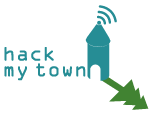Big cities and their surroundings are developing, all around the world, through a new model where the information infrastructure contributes to the creation of info-ecosystems such as ‘smart mobility and last-mile logistics’, ‘smart health’, ‘smart government’, ‘smart culture and tourism’, the sustainability of the natural resources and the green economy. Such info-urbanism development is expected to produce social innovation and, inevitably, leads to wonder about what forms can take the smart education underlined by all pieces that compose the mosaic of the info-ecosystems.
Technologies, Web and mobile infrastructures, increasingly embedded into the everyday spaces and artifacts, will make the places not only more sensitive but also responsive and, potentially, coevolutionary. TEP (Technology Enhanced Places) will give rise to new landscapes in which one can experiment, seamlessly, the integration of physicality and virtuality, bringing us opportunities to learn from everyday life
The person, considered in all her complexity, will be placed at the center of educational contexts and scenarios, that become increasingly ubiquitous, complex, organic. The physical space perimeter, where educational experiences develop, will become increasingly undefined and will host more and more nomadic and informal practices characterized by a high density of social interactions. In these scenarios, the mediating role of technology will widen over the time to: foster relationships with the natural environments, filter content needed to support meaningful experiences at glocal level, disclose feedback necessary to learn how to manage ‘in action’, the complexity of staticity and dynamicity, of learning contexts and processes.
Through which educational path will people become participatory-aware citizens of the future ‘SimCities’? How will we learn from the open books that are represented by the art cities? How will data be elaborated, flowing from sensorized areas, to support awareness and learning? How will our behavior be influenced by knowledge of co-evolution mechanisms and limits of the ecosystems? Will the educational infrastructure be smart enough to readjust, even autopoietically, to satisfy the needs that everyone shall develop throughout her life, in different contexts?
The future perspective comprises territories that become increasingly open to awareness and participation and of a ‘smart education’ that becomes more and more spatially widespread and temporally continuous.
Such ideas are not new. Yet, when talking about smart cities, we usually think of services offered to citizens of a big city or metropolis, where the cost of services is amortized through their use by a large number of citizens, or through indirect benefits to the community of reference (eg, greater awareness of the area, improved social cohesion).
Among smart services, we are particularly interested in those through which a community grows and learns, including informal and non-formal learning, thus making the space an urban context of learning and the place for development of active citizenship.
In non-metropolitan contexts, such as in small towns or in rural and mountain areas, service development cost is likely to be economically unsustainable, even considering benefits induced on small communities in a longer period of time.
The possibility of using a “smart” context even in a rural reality requires new ways for designing and developing intelligent services, that are responsive to community needs, and specifically to encourage participation from younger people (who might otherwise consider to leave the territory and move to a city).
In particular, a bottom-up approach involving local people and local administration in the definition of the domain of “smart” solutions is expected to balance the predictable economic unsustainability of the smart services focusing on the motivation of the people involved and the optimization of ad hoc solutions
Both comments and pings are currently closed.

